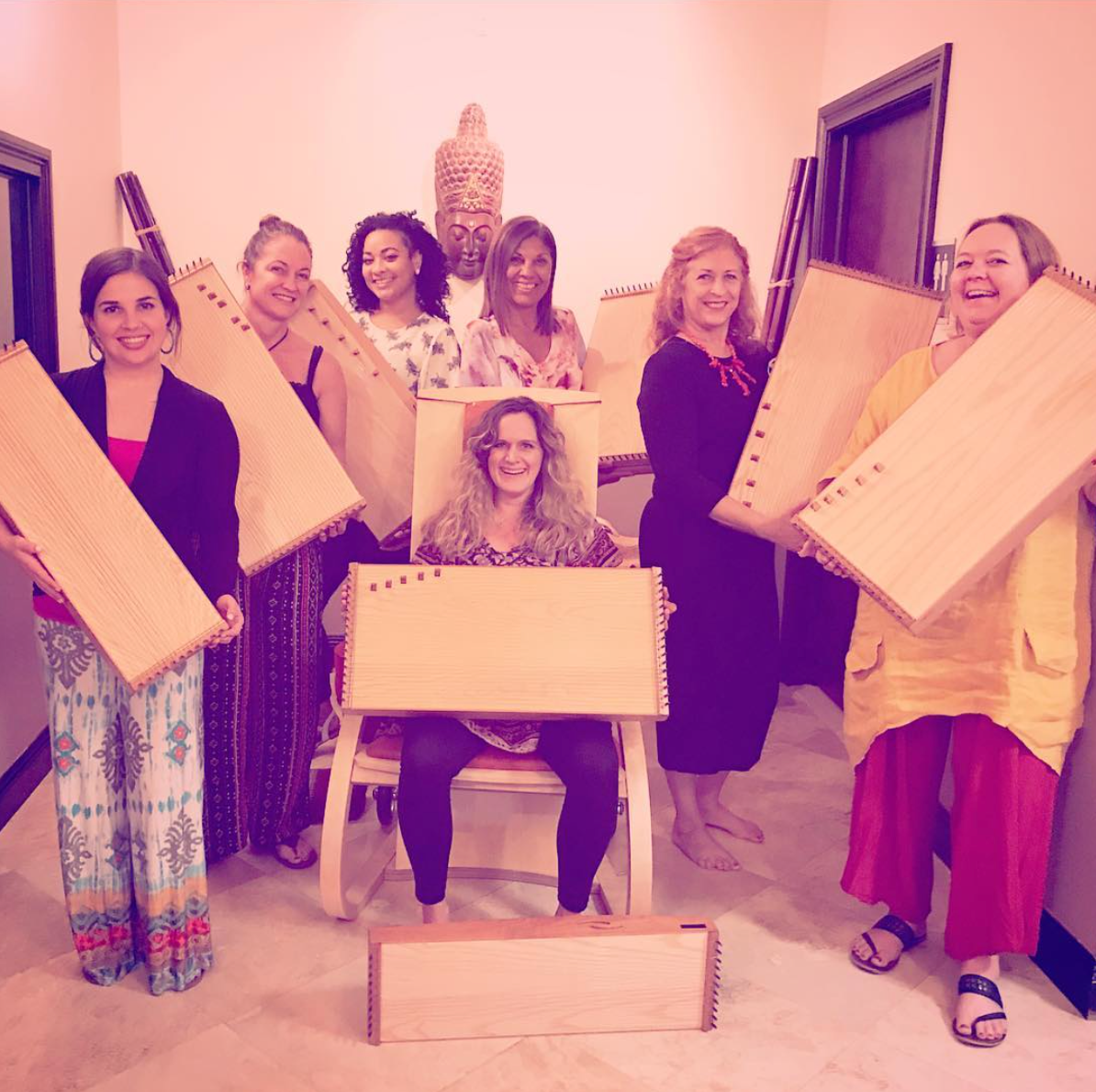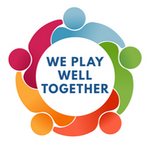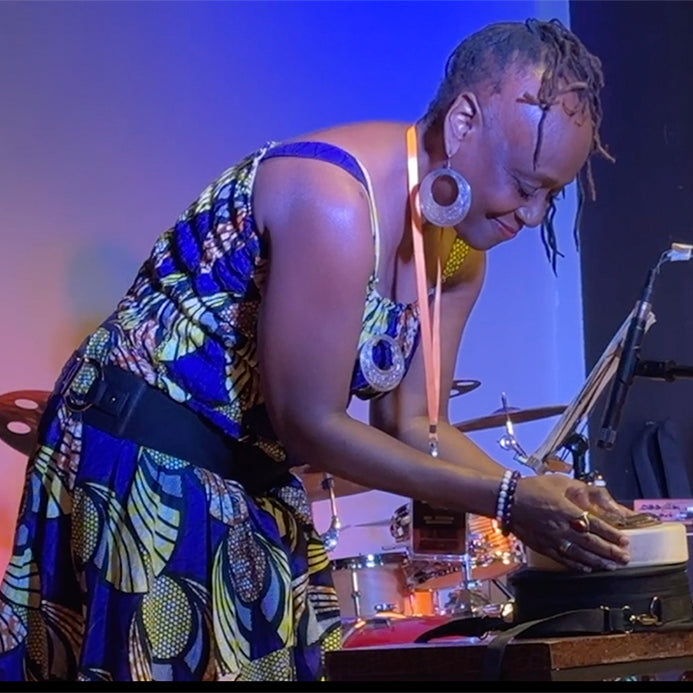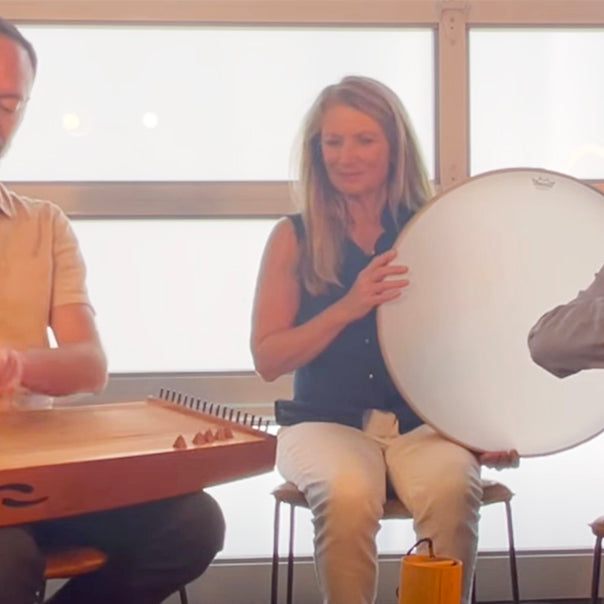

How do you learn how to play an “intuitive” instrument?
By Feeltone US Trainer Joule L'Adara

When I first attended the “Secrets of the Monochord” training, it was after I had already been playing my feeltone Monolina for 3 years. Initially I’d been invited to help translate the workshop from German as the instructor who beautifully created this course, Martina Gläser (having grown up in the former East Germany where Russian was taught in school) doesn’t speak English. Attending this weekend intensive was for me (mind you) after obtaining a Masters degree in Music, having “achieved”: years of voice lessons, piano lessons, music theory, a technical diploma in audio engineering, multiple sound healing certifications, being a Reiki Master, and having developed my own group vocal sound facilitation method I was teaching through workshops and intensive retreats. So when I came across the Feeltone monochords, I thought I only needed to tune this instruments, start strumming them, and glorious tones would emerge. (Partly) this was (totally) true.
I loved the feeltone Instruments from the first moment I was introduced to them back in 2006 at a sound healing conference. My first encounter with the portable Monolini was at my 2011 sound retreat I produced in Hawaii, during which we incorporated the monochord into our group vocal protocol. Playing monochord seemed pretty simple: basically you take your fingers and strum them across the strings. There didn’t seem to be much more to it than that, and when I later interviewed the maker of the Instruments, Ingo Böheme, on my radio show, he’d explained he founded his company with the vision of creating instruments anyone could pick up and play instantly and which have no “wrong notes.” For me, the monochord tone produced a beautiful background drone to my free-form vocalizing. I loved using it in both group sound work and in one-on-one healing sessions that I combined with Reiki and the Acutonics Tuning forks in which I’d also undergone training to know how to use on acupuncture points.
So when it came time to fly to Miami to learn the “Secrets of the Monochord” in a weekend intensive taught by the instrument builder's wife Martina, I was asking myself, “What the heck do we ‘learn’ about playing this instrument for 2.5 days- let alone what would she teach in the “upper level” advanced classes she offers in Germany?
I’m happy to share I was pleasantly surprised. Martina’s course as it turned out, was much less about “mastering playing techniques” (though it does introduce different playing possibilities) and more about gaining mastery over one’s presence by deepening one’s personal relationship to subtle energy. While anyone can strum a monochord, there are certain ways of playing it that elicit a relaxation response in those listening by entraining the brain to meditative states. This workshop was about going beyond mere ego-level improvisation, to develop the awareness of what you are doing, what the effect is, how to reliably recreate it again and again, and ultimately to learn how to bring archetypal forms through sound variations. I discovered tiny changes in parameters could create totally different responses in the body and that the key to mastering these subtle variations was to be able to listen with focused expanded awareness. I came to understand that “Presence" - that illusive but all-important mindfulness concept- came not from pushing one’s energy to be a certain way, but rather from emptying out and thus increasing one’s capacity to receive.

I left the training having felt the monochord and I had been on a couple’s counseling retreat. “OMG!”, I imagined saying to my Monolina, “I’ve been playing you all this time but I haven’t really been LISTENING to you! I’ve been singing over you when all along you had a LOT more to say.” In my mind, I could hear “her” answering, “Yes, Joule: I’ve been waiting patiently all this time just wanting your to HEAR me: to hear the subtleties of the overtones and to sing WITH me in duet instead of over me. I’m so grateful that now we get to co-create together!”
The following year, I attended and translated for this live workshop again after which Martina expressed her wish for me to teach an all-English version of the workshop in the US. I was humbled she would pass her “baby” (the training) on to me and entrust me with bringing through my version of her vision: a magical weekend deep-dive into the current of sound.

(Martina Gläser and I in 2015)
In this course Martina created and which I now have the privilege of teaching regularly in New York, one learns the basics of the monochord: how to tune it, how to care for it, how to change a string, how to play it on a body, how to play it in group, how to pace yourself, and yes, some different playing techniques. However, much more important than technique is the ability to discern, to feel, to allow the music to flow through you, to deepen the ability to transmit energy in the form of acoustic vibration. It’s something that has to be experienced in real time, and being in a live group with these instruments invites the possibility of initiation and attunement: where the group-playing creates an amplifying effect as the combined energy comes into cohesiveness via the stacking of harmonics. The monochord itself functions in this way and the effect grows exponentially with a group playing in unison. Participants emerge from this workshop feeling expanded, whole, clear, creative. The energy coming through the instruments brings the body/mind/spirit into alignment while opening your inner ear to be able to listen deeper and receive more. It is a process of unfoldment that accelerates over two days.

I’m always amazed when trained and accomplished solo musicians come out of this course having gained new perspectives they can apply to their art. Practicing Music Therapists have likewise as much to learn about simplicity and the effects of subtle energy as complete beginners who know nothing about music prior to touching this instrument. Here we find a level playing field where all are welcome and everyone has something to gain.
Monochords are the ultimate mindfulness teachers. Setting their strings into motion initiates a process of beautiful unraveling, peeling away the layers of “knowing” until what’s left is an openness to what is coming through in the moment. Even if we think we know, that practice of unknowing is the “secret” that opens up all the dormant possibilities within us.

Update: in-person Secrets of the Monochord Training NYC is currently on hold due to the Coronavirus Pandemic. No in-person workshops have been held since 2020. We have been offering Part 1 of "Secrets of the Monochord" Online in live small group format. We hope to relaunch the in-person workshops by mid 2022. If you're interested in receiving more information, write to: joule@soundingcircles.com for registration details.
Martina Gläser offers Beginning, Intermediate and Advanced Feeltone Monochord and Sound Therapy Trainings in German: ma-mer.de
CE Credits for this course can be obtained - inquire for more information.
Blog posts
Never got the delivery
Hi Dimitri ,
It looks like the tracking information indicates your package was delivered to your mailbox. Could you check to see if perhaps a neighbor might have picked it up by mistake?
If you still can't locate it, no worries at all—just let us know, and please provide a secure shipping address where we can resend your item.
Looking forward to resolving this for you!
Warm regards,
Gabriele
This is a very beautiful chime that I can play with my Aqua Zenko Element (432Hz), Aqua Tinka Tong (432Hz), & my Aqua Hokema B5 Kalimba (432Hz) with a little help from my friends. Of course, I can mix & match the chimes with other elemental instruments & be amazed by the way that the sounds blend perfectly.
This is my favorite chime that I play before bed for a more restful sleep. I have noticed a little hum with beautiful overtones & undertones when moved around in a circular motion that I particularly enjoy. I can play this with my beloved Terra Tinka Tong or my beautiful Hokema B5 Terra Kalimba.
This is a lovely chime that I play with either my Hokema Terra B5 Kalimba or my Ignis Tinka Tong. The great thing about these chimes is that they sound great mixing & matching them with other instruments from WPWT.
I play these chimes for self care before bed for a more restful sleep.
This Kalimba is pleasing to the eye because of the cut & quality of the cherry wood. The size is perfect for small hands such as mine. I particularly love the Terra Tuning & fell instantly in love with this Kalimba that reminds me of a music box when played.
I also received the Aqua B5 Hokema Kalimba which is equally as beautiful as the Terra.
The Aqua Kalimba completes my Aqua Elemental Soundscape bundle. I cannot say how much I have loved jamming with my set.
This B5 Kalimba may be small, but its sound output is excellent & the tone is perfect. The B5 Kalimba can also be paired with the matching Koshi Chime & easily played. I think that I prefer the size of the B5 Kalimba & would highly recommend it for sound & ease of play.
Thanks & best wishes to the WPWT team.
All that I can say is that I love my Koshi Chimes. Each Elemental Chime is unique & complete in its own light tinkling playful sound & becomes even more beautiful in the complexity of two chimes paired together. I particularly enjoy the calming quality of Aqua & Aria. I also like the joyfulness & energy of Ignis & Terra as they are played together. I bought the Koshi Chimes because they were highly recommended for their durability & because they never go out of tune. I also like the earthiness of the color of bamboo. One day I might like to pair Koshi Chimes with a pop of color from matching Zaphir Chimes.
Now let me throw in the beauty of the B5 Hokema Kalimbas - Terra & Aqua as they are paired with their companion Koshi Chimes. I have small hands & can easily hold & play the B5 Kalimba as I am holding the chime of the same tone in the other hand. This is indeed as lovely as the Elemental Soundscape video.
I like to play the Koshi Chimes before I go to bed as it helps to empty my mind, offer relaxation & sounder sleep.
My thanks again to the WPWT team for providing yet another pleasant experience as I keep adding to my ever growing collection of musical instruments.
The packages arrived in a timely manner and packaged with care. The instrument had the richest tone and a divine frequency, I look forward to using this for sound journeys.
I was pleased with customer service & by the work ethic that this company has. This is my first kalimba that I have ever owned. It is easy to make pretty little melodies & pairs well with the chime of the same key, but admittedly the kalimba sounds louder & sweeter when held & played so it works better when these instruments are played by 2 people. Overall I was pleased with my purchase.
Customer service was yet again excellent. My question was answered promptly by email. Items were mailed promptly & in excellent condition upon arrival. I purchased my Aria Chime & was thrilled by its beauty & by how easy it was to learn to play. All I need to do is slightly move my arm to emit the best sound. Please do not sling your chimes from side to side as it will sound chaotic. There are instructional videos on Youtube that will teach you how to play your chimes correctly. I did purchase a companion Hokema Kalimba in the same key to play with the Koshi chime. The chimes & kalimba do sound beautiful when played together by 2 people. I personally feel that it would be better for me to play 2 Koshi chimes together as it is easier as my coordination is just so so so. I will be adding more Koshi chimes to my growing collection of musical instruments from WPWT. As always I am pleased with my purchase.
This case makes carrying my monalina so easy and I feel confident that she won’t get damaged.
Easy to set up and very sturdy
The wait is over!!! I am now the proud owner of the Aqua (Blue), Aria (Gold), Terra (Green), & Ignis (Red) Tinka Tongs. I purchased the Aqua first just to test the water, & immediately fell in love with the instrument. I purchased the other 3 Tinka Tongs just as soon as they became available. It adds so much more to the experience to play multiple instruments at once. I line the Tinka Tongs vertically & mainly play 2 at a time. It is fun just to hit random notes & to be amazed at the unique sounds to be made. Every note played is indeed beautiful & harmonious.
The majors & minors do pair well together. The Aqua (D Minor) & the Terra (C Major) pair well together.
The Ignis (G Major) & Aria (A Minor) pair well together.
You are not limited to playing minors & majors together. Both the Terra (C Major) & Ignis (G Major) sound well together- so light & happy.
The instruments are well made & sound amazing.
This is a great company to do business with. Emails are promptly responded to. Orders are mailed via UPS within days. The instruments are exceptionally well packaged & arrive in perfect condition.
I look forward to adding the chimes to my collection in the future- Terra & the Ignis in a few months.
Thanks to the hard working team at WPWT.
LOVE this instrument. A calming, soothing sound, played like the wind in a random way, allowing time for pause. This helps clients and participants in a sound bath feel the magic energy of sound.
As a music therapist, and doing sound healing work, I am loving this instrument. It sounds great alone as a way to begin and end a session as it allows people to really drop in. I use it with my Native American flutes as well. Affordable, durable, easy to play, great sounding, relaxing, helps you breathe more deeply.
I first learned of this instrument through Kalani Das of World Drum Club during his Tuesday night video on Youtube & his special guest, Joule L'Adara of We Play Well Together as they were demonstrating the Water Elemental instruments in D Minor & making all of the instruments sound so beautiful. I have purchased a Diatonic C Major tongue drum that Mr. Das recommended in the past that I have been well pleased with so I was confident in the workmanship. I purchased both the Tinka Tong, my preferred instrument, & the Baby Turtle at the same time. The little Zenko tongue drum sounds exactly as it does in the videos on Youtube. The notes are crystal clear & bell like without the annoying reverb. I much prefer the sound of 432 hz as the sound is pleasing filling me with intense pleasure. The carrying case is well made. I really like this instrument paired with the Tinka Tong as it is like PB&J. My Mother ,who is a stroke victim, was able to place the Baby Turtle in her lap while reclining & play beautifully with me for nearly an hour the 1st time that we played together. Now I must give a shout out to Gabriele who promptly responded to my emails, texts, & phone call. Gabriele was courteous & extremely helpful. My shipment went out quickly & arrived via UPS earlier than expected in a well packaged box. I look forward to a long relationship with this company. The employees really worked hard to meet my needs & I am thankful.
I first learned about this instrument through Kali Das of World Drum Club on his Tuesday night video on Youtube and his special guest, Joule L'Adara, of We Play Well Together as they were demonstrating the instruments of the Soundscapes Water Collection in D Minor. I have previously purchased a Diatonic C Major tongue drum that Mr. Das recommended. This drum was very much enjoyed so I was confident that this Tinka Tong was of excellent workmanship & it is. The videos on Youtube of Feeltone & We Play Together demonstrating these instruments are well worth watching as well as the instruments sound exactly as they do at my home. I purchased both, the Zenko Elemental Aqua (Baby Turtle) & The Tinka Tong in D Minor. Both sound great together; however, I prefer the Tinka Tong as it was love at first sight. The Tinka Tong is visually appealing & unique in sound. I like the new design & size of the instrument. While I have no formal music training, I was able to play well immediately. While there are only 6 tongues, there are a never ending amount of melodies & rhythms to be played. Best of all, there are no wrong notes. Warning: the use of this drum is highly addictive as a feeling of pleasure & calm will wash over you. I played with my Mother who is a stroke victim with Aphasia; however, she was able to follow my rhythm at times as she played the Zenko Element. Her musical ability was excellent as she plays the piano. We enjoyed playing for nearly an hour. Music is so beneficial as it yields a total brain workout. I also have to give a shout out to Gabriele (whom I have contacted via email, text, & phone) for her prompt response to my inquiries & for all of the assistance provided. I ordered my items after business hours on a Friday night. Instruments were mailed out the following Monday & arrived earlier than expected via UPS.
This chime (Ignis/red/g-major) makes absolutely captivating sounds, I really love it. I initially made the investment for a meditation workshop I was leading with college students— many of them said that the 7 or so minutes I spent moving around the room with the chime was the very best ("most magical") part of a very enjoyable weekend. I am excited to fine more ways to share it with others! My cats like it too :)
I love the We Play Well Together business model and ethos, and look forward to bringing them more business.
I am a musician. When I was 14 years old I started playing classical guitar. I’m 66 now. I have had a lifelong love of stringed instruments.
About three months ago my wife and I attended a sound bath. As we lay there meditating all the sounds of the evening washed over us and everything was peaceful and then I heard this richness of sound that sounded like a thousand strings moving and pulsing and I sat straight up and looked for the source. The woman who was holding the sound bath was playing a Monolina. I was enthralled by the sound. After the sound bath I went up and I snuck a look at the name and I saw that it said Feeltone
And now its now.
Although the Monolina is be good for sound healing and meditation it is also an instrument with 34 strings! With the use of bridges and alternate tunings I am able to group the strings in note ranges to further utilize its richness of sound. With 34 strings and 10 bridges the possibilities are endless.
As a musician i have seen many hand made instruments. I am very impressed by the ‘luthier’ skills of the people at Feeltone. The instrument is tight. No buzzes. And it looks beautiful. I am looking forward to many years of sound experimentation!
I would also like to the Gabrielle of WePlayWellTogether. She was very helpful. She answered all my many questions promptly and with a positive spirit.
Cool instrument. Nice lady!
David
I love my sansulas very much. This instrument has allowed me to explore music. The Deluxe has such great sound! This is a great company to work with!
The felt mallets are wonderful for playing the Monolina. They are easy to hold and create a nice droning sound.
Very satisfied. The Sansula is as new (is it new?) in the box with paperwork and all. Sounds great!
…i had enjoyed the Sansula app on iPad for several years and finally got around to buying one. What took me so long!?!!? DOH!!
WPWT took excellent care of this customer, quickly fixing a holdiay rush shipping boo-boo.
I love the instrument as well as the vendor.
THANKS!
I absolutely live my magical little instrument. It travels with me for elemental magic on demand
I am in love with my Monalina. I use it regularly and sing with it in sound baths. It is balm for the soul.
This is my second one. The first one gets so much use from my associate sound practitioners I had to get a second one. It’s a favorite of our clients and group meditation attendees!


